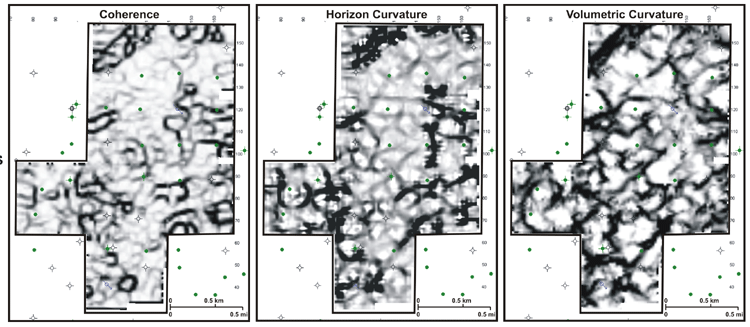http://www.kgs.ku.edu/PRS/AAPG2005/karst/p1-03.html
Last Modified December 2005
|
Using New 3-D Seismic Attributes to Identify Subtle Fracture Trends |
Kansas Geological Survey |
Curvature describes how bent a surface is at a particular point and is closely related to the second derivative of the curve defining the surface. The more bent a surface is, the larger its curvature.
In two dimensions, positive curvature refers to an antiform feature, negative curvature refers to a synform feature, and zero curvature refers to a planar feature. In three dimensions, there are numerous curvature measures that can be extracted, related to the direction of the plane along which curvature is measured.

Various curvature attributes have been shown to reveal useful information relating to folds, faults, and lineaments contained within the surface (Roberts, 2001). Most published work of curvature analysis applied to 3-D seismic data has been limited to calculations based on gridded interpreted horizons (e.g., Hart et al., 2002; Masaferro et al., 2003; Sigismondi and Soldo, 2003)). However, recently, a suite of volumetric curvature attributes has been developed, where reflector curvature is calculated directly from the seismic data volume, with no prior interpretation required (al Dossary and Marfurt, 2005).
Of the numerous volumetric curvatures calculated, the most positive and most negative curvatures, which measure the maximum positive and negative bending of the surface at a given point, are the most useful in delineating faults, fractures, flexures, and folds (Al-Dossary and Marfurt, 2005; Blumentritt et al., 2003, 2005; Serrano et al., 2003; Sullivan et al., 2003, 2005). The most negative curvature volume appears to be the best for viewing fractures. There are several ways that fractures could cause negative bending of a seismic horizon. One possible explanation is that the fractures are open and locally decrease the average velocity of the rock. Another possibility is that the fractures are filled with a lower velocity material, such as shale.
Curvature has proven to be useful in identifying fractures that cannot be identified with conventional 3-D seismic attributes, including coherence. This is because fractures or small-offset faults (with offsets less than one- quarter wavelength) will not cause a break in the seismic reflector, and are thus not detectable by coherence. However, the subtle flexure in the horizons due to these features can be detected by curvature.

Comparison of coherence (left), most negative curvature from gridded, interpreted horizon (middle), and extracted volumetric curvature (right) for the Gilmore City horizon from the Dickman seismic survey. Note that oriented lineaments, which cannot be seen on the coherence map, are visible on the two curvature maps. Also note that the lineaments are better defined on the volumetric curvature map than on the horizon curvature map.